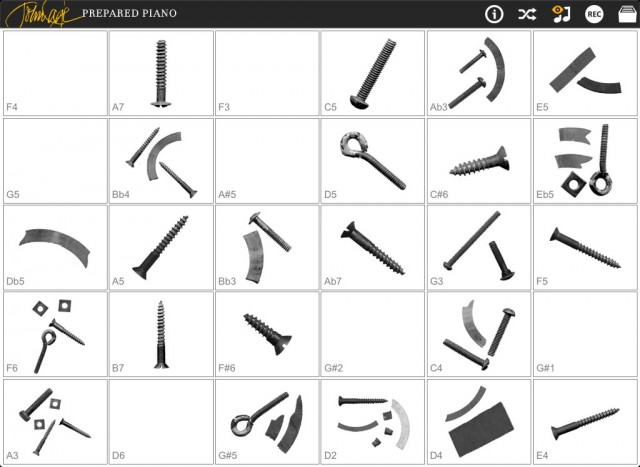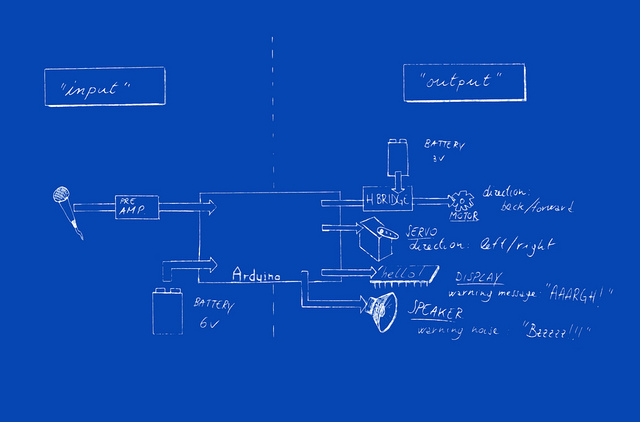
A Cage music walk – or, perhaps, a model for a pro-Cage protest march today – CC-BY Steve Bowbrick
“I Have Nothing to Say and I Am Saying It,” a John Cage title, might well be the creed of the blogger – doubly so this music technology writer. So, here we go again.
The notion of John Cage at 100 is humbling in itself. The idea that Cage is a century old cements the awareness that the radical modern consciousness has a history, that the revolution has arrived and settled in for the winter, repeating itself in cycles of life and death like an endless tape loop.
But to say it as concisely as possible, Cage’s legacy in electronic music can be, should you choose, everything. The frame around silence and sound, the significance of what action and noise can be, can liberate anything you do with musical technology, digital or otherwise. It can change your view of a computer, or a nail on a piano string.
I will therefore say nothing more, and instead point to just a few selections from the many thoughtful noises and words and free YouTube videos posted today.
Happy 100th.
Cage, the App
It lacks the visceral, subversive joy of getting your hands into the off-limits quarters around the string. But as a way to introduce people to prepared piano when no piano is handy – or a way to show your Cage love on your mobile – the John Cage app is special.
Celebrate John Cage’s 100th birthday by playing the CagePiano app on your iOS or Android mobile device.
One of the many ingenious innovations of American composer/writer/artist John Cage was his creation of the “prepared piano”, in which he placed objects beneath and between the strings of a grand piano to create an entirely
new instrument.
The app uses sampled sounds, and not just of any prepared piano – The John Cage Trust supervised recordings of the very materials Cage used on his Sonatas and Interludes (1946-48). You can play the prepared pitches, and share your work socially. A free version is available, a full version is just a dollar, and while it’s iOS-only at the moment, an Android version is coming.
http://johncage.org/cagePiano.html
Cage on the A Train
Allan Kozinn, writing again for The New York Times, for which he wrote Cage’s obituary, has a great suggestion for how to honor Cage today, or any day: listen.
…This Tuesday evening just about all the people were talking, and working hard to drown out both the subway and the chats taking place around them. I would normally have tuned all this out, but instead I sat back, closed my eyes and did what Cage so often recommended: I listened. I made no effort to separate the strands of conversation or to focus on what people were saying. I was simply grabbed by the sheer mass of sound, human and mechanical. It sounded intensely musical to me, noisy as it was, and once I began hearing it that way, I couldn’t stop.
John Cage Recital? Take the A Train
NPR on Understanding Cage
Writing for National Public Radio (the listener-supported American radio network), Anastasia Tsioulcas notes that Cage is still inflammatory a century after his birth. She suggests ways of better understanding this oft-misunderstood composer. This excerpt says it all:
4’33” wasn’t silent and it wasn’t a joke at all. When a pianist does nothing more than lift and close the instrument’s lid, the ambient sounds surrounding the listener, and even the listener’s own breath, become the vehicle for a kind of sonic zazen. It is a stunningly potent invitation to reframe music and the world.
The writer then walks through five critical pieces to understand Cage’s musical imagination and philosophy:
Silence And Sound: Five Ways Of Understanding John Cage
Cage, Cunningham, Tudor: The Prepared Mind
Cage’s long-time choreographic collaborator, Merce Cunningham, expressed chance in movement in parallel to Cage’s sonic work. So, it’s fitting to turn to The Merce Cunningham Trust for more insight into Cage and his circle in New York.
With newly available archival film and photography of John Cage and David Tudor, this webisode also introduces to the series composer-musicians Christian Wolff and Gordon Mumma in recent interviews. Merce Cunningham talks about both Cage and Tudor, as artists and individuals. We include rare footage of John Cage playing his infamous “silent piece,” 4’33”, in Harvard Square and a first look at new footage of Cunningham’s RainForest (1968) filmed by Mondays with Merce at the Mossovet Theater in Moscow in June 2011 under the auspices of the U.S. Department of State and the Chekhov Festival.
EPISODE 15 THE PREPARED MIND: JOHN CAGE AND DAVID TUDOR
Watch: Live Music Performances
As collected by Network Awesome, music instrumental, electronic, electro-acoustic, and — beyond classification:
– Variations V
– Speech
– Waterwalk
– 27 sounds manufactured in a kitchen
– Various texts
– Playing Cactus
– 4’33
Watch: Tribute to Cage by Nam June Paik
Cage and Tudor on Indeterminacy
Mix program Klankschap celebrates Cage with a set of reflections by David Tudor and Cage on indeterminacy in form, both in electronic and instrumental music.
Description:
John Cage would turn 100 this year. This episode of Klankschap is dedicated to the man with the wide grin and profound views, by playing the integral album “Indeterminacy : New aspect of form in Instrumental and Electronic music”.
Cage reads us short and amusing or interesting stories, while David Tudor squirts noise all over the place.
There are four parts. In the tradition of Cagean philosophy, part 1 is followed by part 3, then part 2 and part 4 ends this enchanting listening experience.
You can read the texts whilst listening : http://www.lcdf.org/indeterminacy/
Played live on september, 4th / 2012 @ Villa Bota Studios
in honour of John Cage
Cage and Feldman
The Internet Archive has a fascinating set of conversations between Morton Feldman and John Cage:
John Cage / Morton Feldman: Radio Happenings I – V
Details:
Recorded at WBAI, New York City, July 1966 – January 1967
John Cage and Morton Feldman recorded four open-ended conversations at
the studios of radio station WBAI in New York. These meetings spanned six months between July 1966 and January 1967, and were produced as five “Radio Happenings”. Both were at transitional points in their music. Cage had completed Variations V in 1965 and Variations VI and VII in 1966, and would publish “A Year from Monday” in 1967. Most of Feldman’s important work was yet to come. These conversations between two old friends, relaxed, smoking, and throwing out ideas, are full of laughter and long ponderous silences. They form an incredible historical record of their concerns and preoccupations with making music, art, society, and politics of the moment.In 1993 these conversations were transcribed and published as “Radio Happenings I-V” by Edition MusikTexte in Cologne, Germany, with a German translation and a preface by Christian Wolff. However, the printed page loses so much that can only be experienced by hearing these two speaking together again – even those long, meaningful silences.
V: 16 January 1967 (Part 2)
Varese or Webern? On Boulez. On an upcoming concert in Cincinnati.
Problems, stories of performances. “Why do you continue to compose?” Creating new notation. Students making compositions.
The way things are done nowadays. Things are “less narrow now”.
Children, and the Middle Ages. “If we apply ourselves to the social situation… as composition rather than criticism, we’ll get
somewhere!”
More Reading
Alex Ross has a poetic piece on Cage’s legacy for The New Yorker
The John Cage Century
The blog Music Matters argues Cage’s influence on electronic music is wide-reaching, defying genre:
john milton cage jr.: pioneering electronic music
Turning to matters of performance:
Cage = 100: Tudor and the Performance Practice of Concert for Piano and Orchestra Isaac Schankler, for New Music Box
And Lastly…
I don’t know what this is, exactly, but the Arduino-powered John Cage robot looks simply awesome. CC-BY Emanuele Colonnella.
Updated: The Cage robot is a perfect tribute — the work of Emanuele Colonnella and Alessandro Contini, it’s a prize-winning Arduino creation. See the video:
The John Cage project: a robot that hates noise and looks for silence.
He usually moves forward but if he hears a noise he screams, says “AAAAARGH!” on his display and then changes direction.He is made with parts from an old printer and he is the winner of the first Italian Arduino Camp.
Your Favorite Cage?
Has Cage inspired you? Got thoughts, memories, videos, sounds, music, or robots to share? Let us know in comments. And someone really ought to bake a cake.

